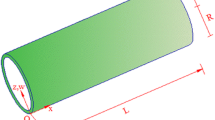Abstract
In this study, a method for energy flow analysis was developed to predict the vibrational responses of coupled cylindrical thin shell structures in the medium-to-high frequency ranges. To extend the application of the energy flow model for out-of-plane waves in the thin shell to coupled structures, the wave transmission analyses of general coupled cylindrical thin shell structures are performed. Power reflection and transmission coefficients on the coupled line were calculated using the coupling relationships established for coupled cylindrical thin shells. Using these coefficients, an energy flow analysis in which a junction was considered, was performed for coupled cylindrical thin shell structures. The junction consisted of an arbitrary number of cylindrical thin shells coupled along a junction line. Through numerical simulations, the energy flow solutions of coupled cylindrical thin shell structures were compared with those of classical displacement solutions, and they showed well-developed energy density global propagation and decay patterns.
Similar content being viewed by others
References
J. C. Wohlever and R. J. Bernhard, Mechanical energy flow models of rods and beams, Journal of Sound and Vibration, 153 (1992) 1–19.
O. M. Bouthier and R. J. Bernhard, Models of spaceaveraged energetics of plates, AIAA Journal, 30 (1992) 616–623.
P. E. Cho, Energy flow analysis of coupled structures, Ph.D. Thesis, Purdue University (1993).
R. S. Langley, Analysis of beam and plate vibrations by using the wave equation, Journal of Sound and Vibration, 150 (1991) 47–65.
R. S. Langley, On the vibrational conductivity approach to high frequency dynamics for two-dimensional structural components, Journal of Sound and Vibration, 182 (1995) 637–657.
H. S. Kim, H. J. Kang and J. S. Kim, A vibrational analysis at high frequencies by the power flow method, Journal of Sound and Vibration, 174 (1994) 493–504.
A. Le Bot, A vibroacustic model for high frequency analysis, Journal of Sound and Vibration, 211 (1998) 537–554.
A. Le Bot, Geometric diffusion of vibrational energy and comparison with the vibrational conductivity approach, Journal of Sound and Vibration, 212 (1998) 637–647.
Y. Lase and L. Jezequel, Analysis of a dynamic system based on a new energetics formulation, Third International Congress on Intensity Techniques (1990) 145–150.
Y. Lase, M. N. Ichchou and L. Jezequel, Energy flow analysis of bars and beams: theoretical formulations, Journal of Sound and Vibration, 192 (1) (1996) 281–305.
D.-H. Park, S.-Y. Hong and H.-G. Kil, Vibrational energy flow models of finite orthotropic plates, Shock and Vibration, 10 (2003) 97–113.
Y.-H. Park and S.-Y. Hong, Vibrational energy flow analysis of corrected flexural waves in Timoshenko beam -Part I: Theory of an energetic model, Shock and Vibration, 13 (2006) 137–165.
Y.-H. Park and S.-Y. Hong, Vibrational power flow models for transversely vibrating finite Mindlin plate, Journal of Sound and Vibration, 317 (2008) 800–840.
H.-W. Kwon, S.-Y. Hong, D.-H. Park, H.-G. Kil and J.-H. Song, Vibrational energy flow models for out-of-plane waves in finite thin shell, Journal of Mechanical Science and Technology, 26 (3) (2012) 689–701.
J.-B. Han, S.-Y. Hong, J.-H. Song and H.-W. Kwon, Vibrational energy flow models for the 1-D high damping system, Journal of Mechanical Science and Technology, 27 (9) (2013) 2659 -2671.
D.-H. Park, S.-Y. Hong, H.-G. Kil and J.-J. Jeon, Power flow models and analysis of in-plane waves in finite coupled thin plates, Journal of Sound and Vibration, 244 (2001) 651–668.
Y.-H. Park and S.-Y. Hong, Vibrational energy flow analysis of corrected flexural waves in Timoshenko beam -Part II: Application to coupled Timoshenko beams, Shock and Vibration, 13 (2006) 167–196.
J.-H. Song and S.-Y. Hong, Development of nonconservative joints in beam networks for vibration energy flow analysis, Shock and Vibration, 14 (2007) 15–28.
J.-H. Song, S.-Y. Hong, Y. Kang and H.-G. Kil, Vibrational energy flow analysis of penetration beam-plate coupled structures, Journal of Mechanical Science and Technology, 25 (3) (2011) 567–576.
H.-W. Kwon, S.-Y. Hong, D.-K. Oh, J. Lee, D.-J. Hwang, O.-S. Kim and J.-H. Song, Experimental study on the energy flow analysis of underwater vibration for the reinforced cylindrical structure, Journal of Mechanical Science and Technology, 28 (9) (2014) 3405 -3410.
A. Le Bot, M. N. Ichchou and L. Jezequel, Energy flow analysis for curved beams, The Journal of the Acoustical Society of America, 102 (2) (1997) 943–954.
R. H. Lyon, In-plane contribution to structural noise transmission, Journal of Noise Control Engineering, 26 (1986) 22–27.
P. A. Manning, Experimental investigation of wave coupling on a cylindrical shell with a keel, Ph.D. Thesis, Massachusetts Institue of Technology (1999).
A. Leissa, Vibration of Shells, Acoustic Society of America (1993).
S. Timoshenko, Theory of Plates and Shells, New York, McGraw-Hill (1940).
K. F. Graff, Wave motion in elastic solids, Oxford University Press (1975).
L. Cremer, M. Heckl and E. E. Ungar, Structure-borne sound, Berlin: Springer-Verlag (1988).
Author information
Authors and Affiliations
Corresponding author
Additional information
Recommended by Associate Editor Junhong Park
Hyun-Wung Kwon received his B.S. degree in Naval Architecture and Ocean Engineering from the Seoul National University, Korea, in 2004 and his Ph.D. in 2009. Currently he is a Professor of Department of Shipbuilding at Koje College, Korea. His primary research interest is energy flow analysis in structures and acoustics.
Jee-Hun Song received his B.S. degree in Naval Architecture and Ocean Engineering from the Seoul National University, Korea, in 2003, and his Ph.D. in 2007. Currently he is a Professor of Naval Architecture and Ocean Engineering at Chonnam National University, Korea. His primary research interest is energy flow analysis in structures.
Rights and permissions
About this article
Cite this article
Kwon, HW., Hong, SY. & Song, JH. Vibrational energy flow analysis of coupled cylindrical thin shell structures. J Mech Sci Technol 30, 4049–4062 (2016). https://doi.org/10.1007/s12206-016-0818-x
Received:
Revised:
Accepted:
Published:
Issue Date:
DOI: https://doi.org/10.1007/s12206-016-0818-x




